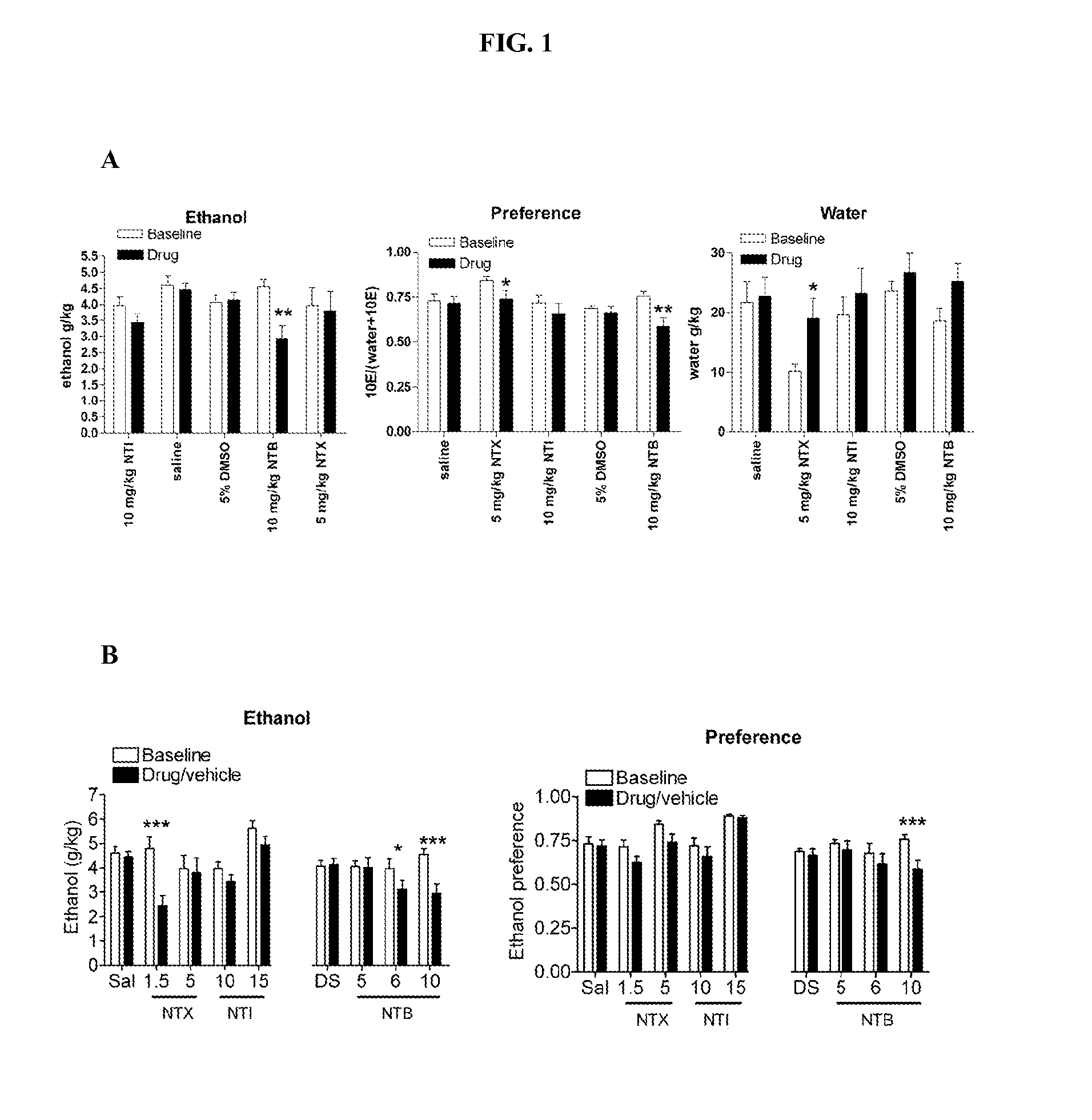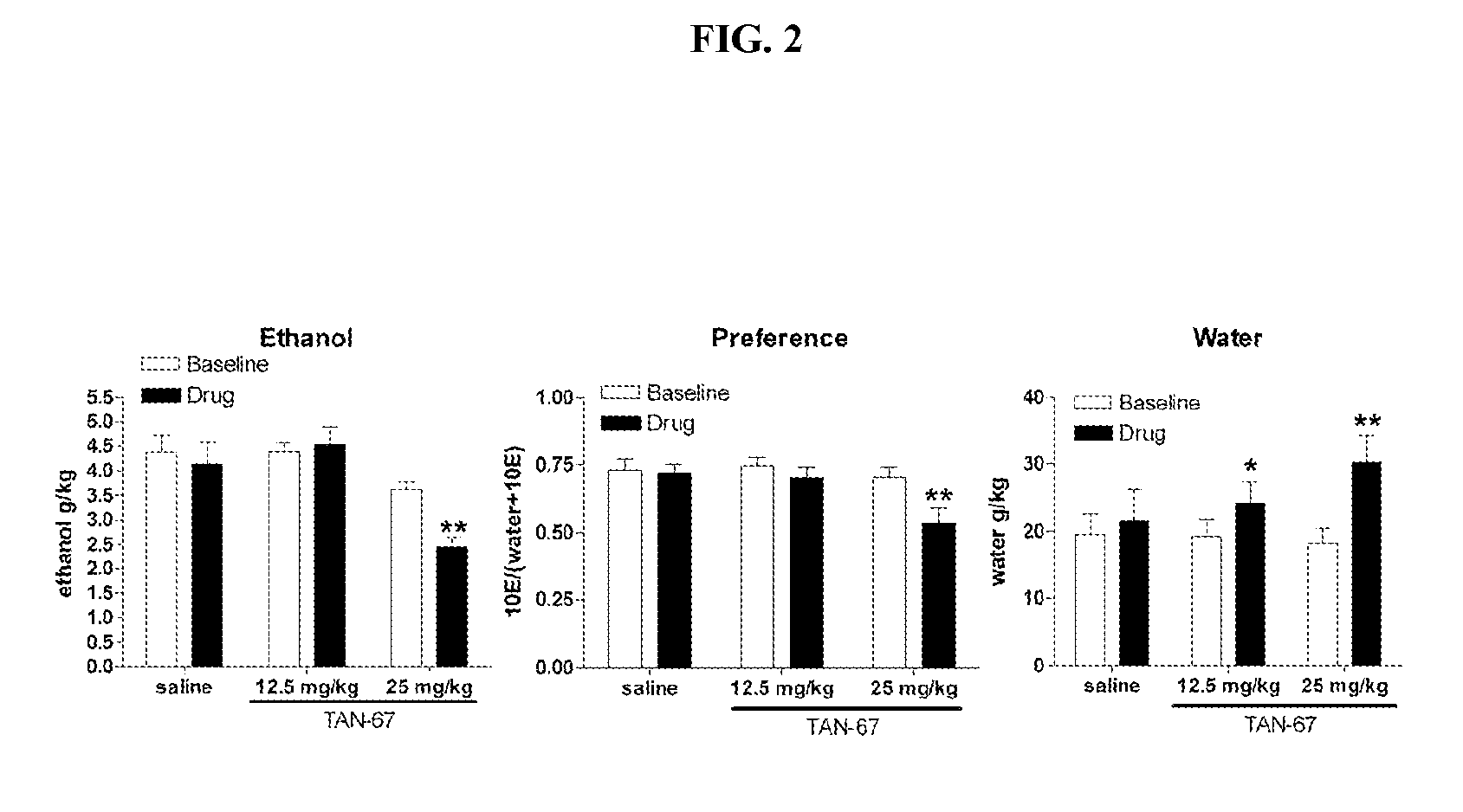Methods of determining delta opioid receptor subtypes
a technology of delta opioid receptor and subtype, which is applied in the direction of metabolism disorder, peptide/protein ingredient, instruments, etc., can solve the problems of significant and unpleasant withdrawal symptoms, alcohol dependence is one of the most serious public health problems worldwide, and achieves the effect of reducing the severity of the substance-related disorder
- Summary
- Abstract
- Description
- Claims
- Application Information
AI Technical Summary
Benefits of technology
Problems solved by technology
Method used
Image
Examples
example 1
8.1 Example 1
The DOP-R2 Antagonist Naltriben (NTB) Dose Dependently Decreases Ethanol Consumption in C57BL / 6 Mice
[0358]The present example demonstrates the effect of the DOP-R2 selective antagonist naltriben (NTB) and the non selective ligands naltrexone (NTX) and naltrindole (NTI) on ethanol consumption and preference in C57BL / 6 mice.
[0359]Material and Methods
[0360]Animals and Housing.
[0361]Male C57BL / 6 mice (20-23 g, Taconic) were individually housed in ventilated PLEXIGLAS® cages at ambient temperature (21° C.) in a room maintained on a reversed 12L:12D cycle (lights off at 10.00, lights on at 22.00). Food and water was provided ad libitum. The mice were given time to acclimatize to the individual housing conditions and reverse light cycle before the start of the experiments. Mice were weighed weekly. All procedures were pre-approved by the Gallo Center Institutional Animal Care and Use Committee and were in accordance with National Institutes of Health Guide for the Care and Use...
example 2
8.2 Example 2
The DOP-R1 Agonist TAN-67 Decreases Ethanol Consumption in C57BL / 6 Mice
[0371]The present example demonstrates the effect of TAN-67 on ethanol consumption in C57BL / 6 mice.
[0372]For materials and methods please refer to Example 1.
[0373]Results
[0374]Since the DOP-R2-selective antagonist NTB but not the DOP-R1 / R2 selective antagonist NTI decreased ethanol consumption, antagonism of DOP-R1 with NTI could be opposing the effects of NTI at DOP-R2. To examine this possibility, the effect of the DOP-R1-selective antagonist BNTX and the DOP-R1-selective agonist TAN-67 on ethanol consumption was tested. BNTX (10 mg / kg) did not affect ethanol consumption (FIG. 2), unlike the DOP-R2-selective antagonist NTB (FIG. 1). In contrast, administration of the DOP-R1 agonist TAN-67 showed a dose-dependent decrease in ethanol consumption and preference (FIG. 2). This effect was blocked by the DOP-R1 antagonist BNTX (25 mg / kg, FIG. 2).
example 3
8.3 Example 3
TAN-67 Decreases Ethanol Consumption by Activation of DOP-R1, NTB Decreases Ethanol Consumption by Inhibition of DOP-R2
[0375]The present example demonstrates the effect of TAN-67 and NTB on ethanol consumption in C57BL / 6 mice.
[0376]For materials and methods please refer to Example 1.
[0377]Results
[0378]Because the DOP-R1 and DOP-R2 are defined solely by pharmacology, whether the DOP-R1 agonist TAN-67 and the DOP-R2 antagonist NTB decrease ethanol consumption by acting on different receptor sites was tested. Co-administration of DOP-R1 agonist TAN-67 (25 mg / kg) together with the DOP-R2 antagonist NTB (10 mg / kg) caused a greater decrease in drinking than either drug alone (FIG. 3A). Furthermore, co-administration of low amounts of NTB (5 mg / kg) and TAN-67 (12.5 mg / kg), that by themselves have no effect on ethanol consumption, caused a significant decrease in ethanol consumption (FIG. 3B).
PUM
| Property | Measurement | Unit |
|---|---|---|
| molecular weight | aaaaa | aaaaa |
| molecular weight | aaaaa | aaaaa |
| molecular weight | aaaaa | aaaaa |
Abstract
Description
Claims
Application Information
 Login to View More
Login to View More - R&D
- Intellectual Property
- Life Sciences
- Materials
- Tech Scout
- Unparalleled Data Quality
- Higher Quality Content
- 60% Fewer Hallucinations
Browse by: Latest US Patents, China's latest patents, Technical Efficacy Thesaurus, Application Domain, Technology Topic, Popular Technical Reports.
© 2025 PatSnap. All rights reserved.Legal|Privacy policy|Modern Slavery Act Transparency Statement|Sitemap|About US| Contact US: help@patsnap.com



